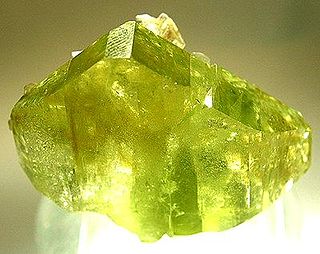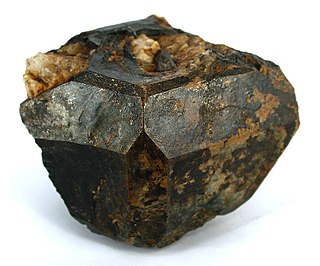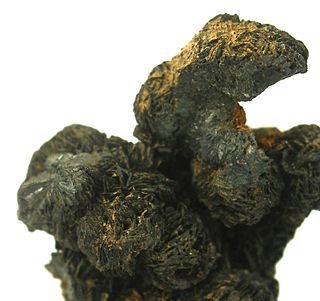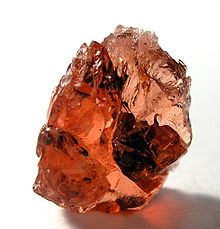
Amblygonite is a fluorophosphate mineral, (Li,Na)AlPO4(F,OH), composed of lithium, sodium, aluminium, phosphate, fluoride and hydroxide. The mineral occurs in pegmatite deposits and is easily mistaken for albite and other feldspars. Its density, cleavage and flame test for lithium are diagnostic. Amblygonite forms a series with montebrasite, the low fluorine endmember. Geologic occurrence is in granite pegmatites, high-temperature tin veins, and greisens. Amblygonite occurs with spodumene, apatite, lepidolite, tourmaline, and other lithium-bearing minerals in pegmatite veins. It contains about 10% lithium, and has been utilized as a source of lithium. The chief commercial sources have historically been the deposits of California and France.

A pegmatite is an igneous rock showing a very coarse texture, with large interlocking crystals usually greater in size than 1 cm (0.4 in) and sometimes greater than 1 meter (3 ft). Most pegmatites are composed of quartz, feldspar, and mica, having a similar silicic composition to granite. However, rarer intermediate composition and mafic pegmatites are known.

Brazilianite, whose name derives from its country of origin, Brazil, is a typically yellow-green phosphate mineral, most commonly found in phosphate-rich pegmatites.

The mineral group tantalite [(Fe, Mn)Ta2O6] is the primary source of the chemical element tantalum, a corrosion (heat and acid) resistant metal. It is chemically similar to columbite, and the two are often grouped together as a semi-singular mineral called coltan or "columbite-tantalite" in many mineral guides. However, tantalite has a much greater specific gravity than columbite (8.0+ compared to columbite's 5.2). Iron-rich tantalite is the mineral tantalite-(Fe) or ferrotantalite and manganese-rich is tantalite-(Mn) or manganotantalite.

Lithiophilite is a mineral containing the element lithium. It is lithium manganese(II) phosphate with chemical formula LiMnPO4. It occurs in pegmatites often associated with triphylite, the iron end member in a solid solution series. The mineral with intermediate composition is known as sicklerite and has the chemical formula Li(Mn,Fe)PO4). The name lithiophilite is derived from the Greek philos (φιλός) "friend", as lithiophilite is usually found with lithium.

Triploidite is an uncommon manganese iron phosphate mineral with formula: (Mn, Fe)2PO4OH. It crystallizes in the monoclinic crystal system and typically occurs as elongated and striated slender prisms which may be columnar to fibrous. Its crystals may be pinkish to yellowish brown or red-orange.

Zanazziite is a complex hydrated phosphate mineral from the roscherite group. It is a magnesium beryllium phosphate mineral. Zanazziite arises as barrel-shaped crystals and can reach up to 4 mm. It grows alongside quartz minerals. It is found in the crevices of Lavra da Ilha pegmatite, near Taquaral, in northeastern Minas Gerais, Brazil. Zanazziite is named after Pier F. Zanazzi. Zanazziite has an ideal chemical formula of Ca2Mg5Be4(PO4)6(OH)4·6H2O.

Microlite was once known as a pale-yellow, reddish-brown, or black isometric mineral composed of sodium calcium tantalum oxide with a small amount of fluorine. Its chemical formula is(Na,Ca)2Ta2O6(O,OH,F). Today it is a name of a group of oxide minerals of a similar stoichiometry having tantalum prevailing over titanium and niobium. The microlite group belongs to a large pyrochlore supergroup that occurs in pegmatites and constitutes an ore of tantalum. It has a Mohs hardness of 5.5 and a variable specific gravity of 4.2 to 6.4. It occurs as disseminated microscopic subtranslucent to opaque octahedral crystals with a refractive index of 2.0 to 2.2. Microlite is also called djalmaite, but both names are now obsolete.

Eosphorite is a brown (occasionally pink) manganese hydrous phosphate mineral with chemical formula: MnAl(PO4)(OH)2·H2O. It is used as a gemstone.

Betafite is a mineral group in the pyrochlore supergroup, with the chemical formula (Ca,U)2(Ti,Nb,Ta)2O6(OH). Betafite typically occurs as a primary mineral in granite pegmatites, rarely in carbonatites. Originally defined by the B-site atom Ti, the development of new nomenclature for mineral names led to modernization of the system for nomenclature of pyrochlore and betafite in order to further rationalize the naming process of this grouping of minerals. Only two of the mineral species that were formerly recognized as betafite are presently retained. They are oxyuranobetafite and oxycalciobetafite. The term betafite is now a synonym or varietal group name under the pyrochlore super group.

Beraunite is an iron phosphate mineral. It was first described by August Breithaupt for an occurrence in Beraun currently in the Czech Republic. Beraunite occurs as a secondary mineral in iron ore deposits, and as an alteration product of primary phosphate minerals in granite pegmatites.

Cyrilovite (NaFe33+(PO4)2(OH)4·2(H2O)) is a hydrous sodium iron phosphate mineral. It is isomorphous and isostructural with wardite, the sodium aluminium counterpart.

Hureaulite is a manganese phosphate with the formula Mn2+5(PO3OH)2(PO4)2·4H2O. It was discovered in 1825 and named in 1826 for the type locality, Les Hureaux, Saint-Sylvestre, Haute-Vienne, Limousin, France. It is sometimes written as huréaulite, but the IMA does not recommend this for English language text.

Hagendorfite is an iron phosphate mineral with the chemical formula of (Na,Ca)MnFe2(PO4)3 and is named after where the mineral was discovered, Hagendorf-Süd, Bavaria, Germany.

Ludlamite is a rare phosphate mineral with chemical formula (Fe,Mn,Mg)3(PO4)2·4H2O. It was first described in 1877 for an occurrence in Wheal Jane mine in Cornwall, England and named for English mineralogist Henry Ludlam (1824–1880).

Whiteite is a rare hydrated hydroxyphosphate mineral.
Bobfergusonite is a mineral with formula Na2Mn5FeAl(PO4)6. The mineral varies in color from green-brown to red-brown. It was discovered in 1986 in Manitoba, Canada, and named for Robert Bury Ferguson (born 1920). As of 2012, the mineral has only been found in Canada and Argentina.

Ixiolite is an accessory oxide mineral found in granitic pegmatites. It is an oxide with the general chemical formula (Ta,Nb,Sn,Mn,Fe)4O8 or (Ta,Mn,Nb)O2.

Ferronigerite-2N1S is an iron, tin, alumino-hydroxide mineral that naturally occurs around sillimanite-quartz veins. Ferronigerite-2N1S belongs to the nigerite group, högbomite supergroup. The other constituents of the nigerite group are ferronigerite-6N6S, magnesionigerite-2N1S, magnesionigerite-6N6S, zinconigerite-2N1S and zinconigerite-6N6S. The 2N1S ending stands for the nolanite and spinel structural layers.

Serrabrancaite is a mineral with the chemical formula MnPO4•H2O and which is named for the locality where it was found, the Alto Serra Branca Pegmatite. The Alto Serra Branca mine has been in operation since the 1940s. It is located in Paraiba, Brazil near a village named Pedra Lavrada. Tantalite is the main mineral mined here. Specimens of serrabrancaite are kept in the Mineralogical Collections of both the Bergakademie Freiberg, Germany and the Martin-Luther Universität Halle, Institut für Geologische Wissenschaften.




















